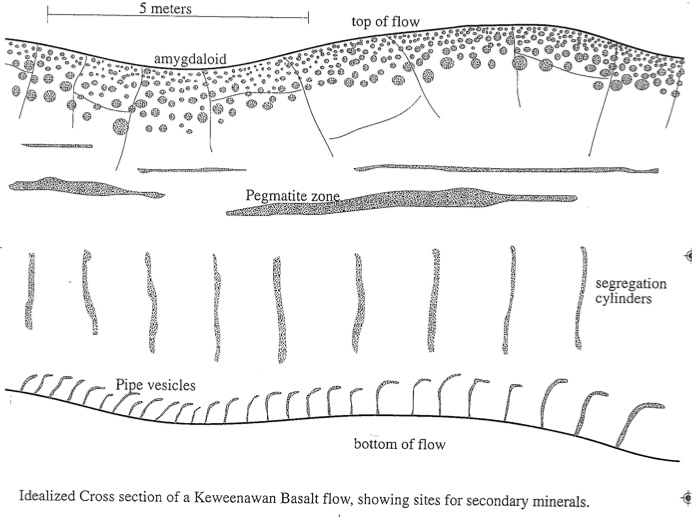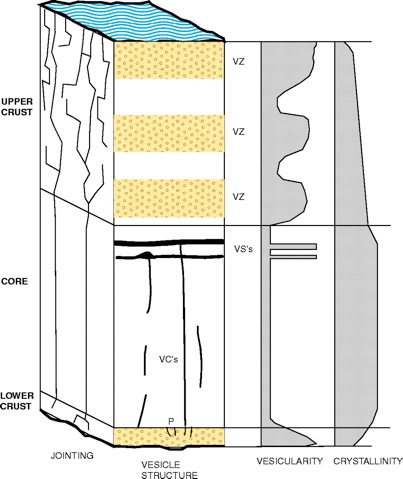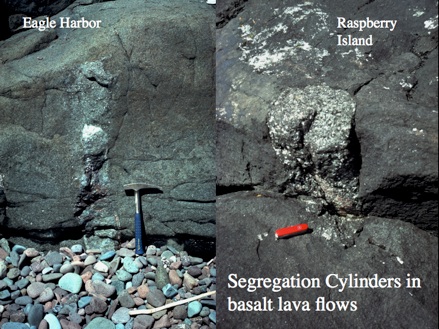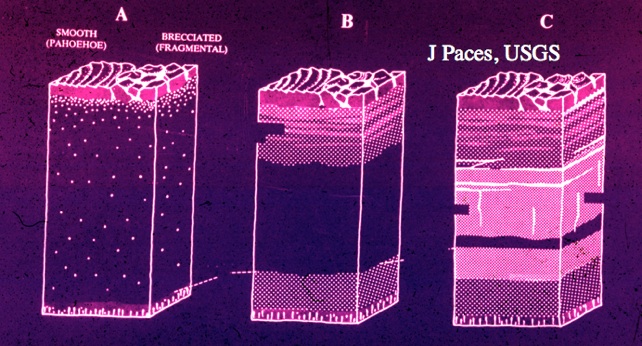




Some good things to read:
Thordarson & Self 2012 Roza Flow JGR
Goff F. 1996. Vesicle cylinders in vapor-differentiated basalt flows. J. Volcanol. Geotherm. Res. 71:167-185.
Hon K, Kauahikaua J, Denlinger R, Mackay K. 1994. Emplacement and inflation of pahoehoe sheet flows: observations and measurements of active lava flows on Kilauea Volcano, Hawaii. Geol. Soc. Am. Bull. 106:351–70

Idealized cartoon of the cross section through an inflated pahoehoe lobe. The lobe is divided into three sections on the basis of vesicle structures, jointing, and crystal texture. The upper crust makes up 40–60% of the lobe and the lower crust is 20–100 cm thick, irrespective of the total lobe thickness. Upper crust: Vesicular, often with discrete horizontal vesicular zones (VZs) that form during active inflation. Bubble size increases with depth. Prismatic or irregular jointing, sometimes equivalent to the entablature in thick lava flows. Petrographic texture ranges from hypohyaline to hypocrystalline (90–10% glass). Core: Very few vesicles. Porosity is dominated by diktytaxitic voids. Vesicles are mostly in the silicic residuum, which forms vesicle cylinders (VCs) and vesicle sheets (VSs). Holocrystalline (<10% glass). Lower crust: Nearly as vesicular as the upper crust, few joints, and 50–90% glass.
from Self et al., 1998.
The most common rock type at the surface of the Earth, and on the other terrestrial planets, is basalt. Basaltic lavas come in two forms: aa and pahoehoe (from the Hawaiian ‘a’ā and pāhoehoe). Pahoehoe flows have often been thought of as small, slow-moving, inconsequential lavas. It is thus not surprising that the processes involved in the emplacement of large, fast-moving, channelized aa flows have received greater attention (see Kilburn & Luongo 1993, Crisp & Baloga 1994, Pinkerton & Wilson 1994, and references therein). However, as in the fable of the tortoise and the hare, it is the slow but unrelenting pahoehoe lava flows that ultimately grow larger and longer than the spectacular but short-lived channelized rivers of lava that produce aa flows.
In terms of both areal coverage and total volume, pahoehoe flows dominate basaltic lavas in the subaerial and submarine environments on Earth. The most abundant type of lava, submarine pillows, is closely related to pahoehoe in their style of emplacement (e.g. Macdonald 1953, Williams & McBirney 1979). A compilation of the rather sparse information on intermediate length (50–100 km) and long (>100 km) lava flows on the Earth (Table 1) shows that pahoehoe is far more common in these larger flows. Several large extraterrestrial flows also seem to be pahoehoe (e.g. Theilig & Greeley 1986, Bruno et al 1992, Campbell & Campbell 1992). The emplacement of pahoehoe flows is therefore a fundamental process in crustal formation on the Earth and the other terrestrial planetary bodies.
excerpt from The importance of pahoehoe: Review paper by Self et al., 1998


Cross section cartoons of Keweenawan lava flows at various stages of solidification, from Paces (1988). A is an early stage when crust has formed on the top and bottom of the flow, While B and C show later stages in solidification as liquid (darkest color) is progressively restricted to the interior, away from the cooling margins where magma is becoming a crystal mush and eventually a solid, and segregations develop from mushy regions.
Analogy with solidification in sills, based on work by Bruce Marsh (Marsh et al., 1991; Mangan & Marsh, 1992) also shows how liquid can be squeezed out of mush below forming a cylindrical feature moving up and then trapped in a horizontal layer.
Listen to lecture about this from Bruce Marsh.

Vesicle cylinders or segregation cylinders are preserved in many places within the core of lava flows, including many examples from the Keweenaw and Isle Royale. On Raspberry Island there is a spectacular display of hundreds of these.
Idealized cross section of a Keweenawan lava flow, showing typical features and their general spatial relations to the flow top, bottoms and interiors. The conspicuous features are the amygdaloid, near the flow top, the pegmatite (or pegmatoid) zone, above the mid point, segregation cylinders or vesicle cylinders (see Raspberry Island page), below the midpoint, and pipe vesicles, at the flow bottom.
Some conclusions about the lavas of the Keweenaw Rift:
-
1.The overall physical characteristics resemble other examples from much younger flood basalts and other basaltic volcanoes.
-
2.The PLV are subaerial, inflated pahoehoe flows which are ponded and do not deflate after eruption.
-
3.The volumes of PLV flows are as large as any known in other flood basalts.
-
4.Because their thicknesses are in excess of hundreds of feet, PLV flows show more pronounced in situ differentiation than other examples.

